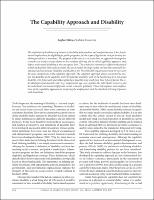| dc.description.abstract | The definition of disability is of interest to disability policymakers and analysts because it has fundamental
implications for eligibility for public programs, for the scope of legislation, and for the way disability
prevalence is measured. The purpose of this article is to assess how an approach developed in
economics to analyze issues related to the standard of living, the so-called capability approach, may
help us understand disability at the conceptual level. The article first summarizes different theoretical
models of disability (the medical model, the social model, the Nagi model, and the International Classification
of Functioning, Disability and Health of the World Health Organization) and then presents
the main components of the capability approach. The capability approach allows researchers to analyze
(a) disability at the capability level; (b) potential disability; and, at the functioning level, (c) actual
disability. This framework also helps explain how disability may result from three types of factors: the individual’s
personal characteristics (e.g., impairment, age, race, gender), the individual’s resources, and
the individual’s environment (physical, social, economic, political). The article explores some implications
of the capability approach for analyzing the employment and the standard of living of persons
with disabilities. | |

